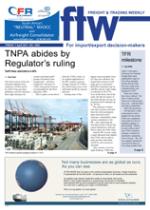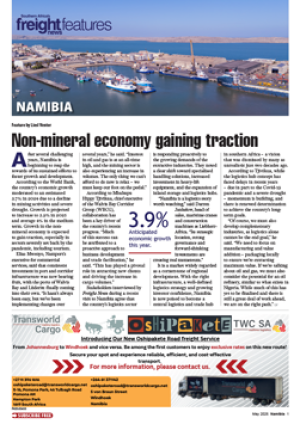Plans by Transnet to invest in
new equipment for the ageing
and somewhat dilapidated
Pier 2 – the Durban container
terminal (DCT) – have met
with criticism from a senior
executive in the freight
industry.
He believes the money
is coming from the wrong
source. Much of Transnet’s
investment funding has come
from the cargo dues which
are paid to Transnet National
Ports Authority (TNPA).
But this money, he
added, is supposed to be for
port development – which
means dredging out harbour
channels and building quays
at harbour side, not buying
equipment for present
terminal handling functions.
Our source also felt that
the upgrading of the terminal
should not be undertaken by
Transnet, “but given to the
private sector to change and
develop”.
This follows a recent
presentation by new Transnet
CEO Brian Molefe on the
parastatal’s investment plan
for the next five years –
spending R110.5 billion to
improve the performance of
SA’s logistical system, which
is currently constraining
export-led growth.
He said in his summary
that particular attention
would be given to boosting
the operational performance
of Pier 2, which was
currently under-performing,
despite being SA’s largest
terminal – something that
would be addressed through
investment in state-of-theart
equipment and in further
training.
Molefe also said that
Transnet was already open to
private sector participation,
from increasing its wagon
fleet to the private operation
of port terminals in Durban.
But he also warned that
the inclusion of the private
sector should not be driven
ideologically.
The private sector was
not a “panacea” for all the
problems with the state
owned enterprises (SoEs).
In fact, he said that it was
possible for SoEs to operate
efficiently, and also to deliver
a societal benefit beyond the
generation of profits, which
was the primary focus of a
private investor.
But the FTW executive
source stood by his objection
to the Molefe plans, and said
that Transnet should rather be
investing its time and money
in developing new or different
terminal facilities than a
major re-equipping of Pier 2.
He believes the best option,
and the one that seems to
meet with the most private
sector support at present, is
the planned dig-out of the old
Durban International Airport
(DIA) site.
It’s already a developed
site, FTW was told, and there
are no real environmental
objections to the area being
dug out to form a completely
new and separate port, with
an entrance channel being
dug on the eastern end of the
Bluff.
The private sector also
feels that it would be a good
alternative, because – unlike
digging out the southern end
of the present harbour – it
would not see the already
heavily congested South
Coast Road access even
further jammed up. Molefe
estimated that it could cost
R20bn-plus to buy, dig out
and equip a new harbour
at the old airport site – but
calculations showed that
the overall project would
probably cost close to R100bn
and would require private
sector capital and expertise
to build and possibly even to
operate.
However, he stressed that
it was likely that the property
would remain within the
“SoE family”.
But it’s no short-term
solution, and it would be years
yet before actual development
could take place, according to
Molefe. He also felt that, only
once the existing facilities had
been debottlenecked, would
the DIA site be added to give
yet more capacity and to take
advantage of an expected
expansion of SA’s commodity
and manufactured production
and exports.
Private sector angles for a slice of Durban port action
01 Apr 2011 - by Alan Peat
0 Comments
FTW - 1 Apr 11

01 Apr 2011
01 Apr 2011
01 Apr 2011
01 Apr 2011
01 Apr 2011
01 Apr 2011
